National Standardised Assessments for Scotland: national report 2022 to 2023
Summary of outcomes at a national level on the 'Scottish National Standardised Assessments' (SNSA) and ‘Measaidhean Coitcheann Nàiseanta airson Foghlam tron Ghàidhlig’ (MCNG) (collectively known as NSA) in the 2022 to 2023 academic year.
3 Reading/Literacy
3.1 The scope of the reading/literacy assessment
3.1.1 Reading and literacy for P1, P4, P7 and S3
For P4, P7 and S3, the assessments of reading and writing are delivered separately. For P1, children are presented with a single assessment combining elements of reading and writing – this is referred to as the P1 literacy assessment. There are two reasons for combining reading and writing at P1. First, literacy skills tend to be quite integrated at this early stage of development (and may be referred to as 'precursor' or 'component' literacy skills). Secondly, a combined literacy assessment reduces the burden of the assessment, which is an important consideration for the very young children in this stage. The P1 literacy assessment is scaled with the reading assessments for higher stages, using the same set of curriculum organisers, and is therefore discussed in this section in conjunction with the outcomes of the P4, P7 and S3 reading assessments.
The P1 literacy assessment comprised both stand-alone items and 'units', which are groups of questions focusing on a single stimulus text. At P4, P7 and S3, all the reading items were grouped into units of four or five items, to economise on the reading load. Using this unit structure, items of differing difficulty and covering different organisers could be asked with reference to the same text.
3.1.2 Alignment with Curriculum for Excellence
In the NSA academic year 2022 to 2023, the assessments of reading and P1 literacy were based on elements of Curriculum for Excellence (CfE), as articulated in the Benchmarks: Literacy and Gàidhlig, published in March 2017 and the Benchmarks: Literacy and English, published in June 2017.
3.1.3 A note on texts used in NSA reading assessments
For NSA reading in English and Gaelic, a broad definition of texts was used, in line with the statements in Benchmarks: Literacy and English (June 2017): 'Challenge in literacy … involves engaging with a wide range of increasingly complex texts which are suitable to the reading age of each learner.' In NSA, this range includes narrative fiction and non-fiction, description, explanation, argument and instructions. A further dimension to the definition of texts in NSA reading relates to format, as described in Curriculum for Excellence: Literacy and English, Principles and Practice: 'Texts can be in continuous form, including traditional formal prose, or non-continuous, for example charts and graphs.'
3.2 Coverage of the Curriculum for Excellence
NSA are just one part of the range of assessments that teachers use in making their evaluations of children's and young people's learning. As a standardised assessment with a defined number of items and using items capable of being scored automatically, only some parts of the specified reading Benchmarks could be addressed. In consultation with Scottish literacy experts, it was agreed that the reading and P1 literacy assessments should be based on the organisers Tools for reading (TFR), Finding and using information (FUI), and Understanding, analysing and evaluating (UAE). The assessment questions for the NSA reflect the knowledge, skills understanding, and standards embedded within the Curriculum for Excellence Experiences and Outcomes for reading, writing and numeracy across the CfE Levels, in accordance with the most up to date Education Scotland advice and curricular guidance on experiences and outcomes and Benchmarks.
Although all three organisers are represented in the P1, P4, P7 and S3 reading assessments, there were different proportions across the stages. In the reports provided to schools, teachers received information about organiser-level outcomes if the learner was presented with at least five items from the organiser. Similarly, in this report, outcomes for organisers that were addressed by at least five items in each learner's assessment are analysed. The organisers included in the reports are shown by stage, in Table 1.
| Stage | Organisers |
|---|---|
| Primary 1 | Tools for reading; Finding and using information; Understanding, analysing and evaluating. |
| Primary 4 | Tools for reading; Finding and using information; Understanding, analysing and evaluating. |
| Primary 7 | Tools for reading; Finding and using information; Understanding, analysing and evaluating. |
| Secondary 3 | Tools for reading; Finding and using information; Understanding, analysing and evaluating. |
The following sections provide more information on each of the reading organisers in NSA 2022 to 2023, along with some example items. These items are not used in NSA 2023 to 2024, and they will not be used in future Scottish National Standardised Assessments.
The information in sections 3.2.1 - 3.2.3 apply to SNSA. MCNG examples and descriptions can be found in sections 3.2.4 - 3.2.6 of this report.
3.2.1 SNSA Tools for reading
In the P1 assessment, this organiser comprised items related to phonological awareness, word decoding and word recognition; in the assessments for the upper stages, assessment content mainly referred to learners' use of strategies to work out the meaning of words. The P4, P7 and S3 assessments contained relatively small numbers of items from this organiser in the academic year 2022 to 2023.
Figure 16 shows a typical item from the P1 literacy assessment, which reflects the organiser Tools for reading. It is designed to assess children's knowledge of sounds (phonological awareness). Note that the 'audio’ icon indicates to the learner that there is a voiced component to the item, enabling the child to listen to the instruction. In this case, clicking on the icon prompts a reading of the item text to the child.

This item asks the child to match the grapheme to the aurally presented phoneme, a skill which, in English, is a key precursor to mastery of reading. The focus of the item is unambiguously on phonological awareness the sounds (phonemes) and corresponding letter/s (graphemes) which represent them) rather than decoding. This item was classified as being at the bottom of the P1 literacy item difficulty range. It was presented to children near the beginning of the assessment, with almost all children were able to answer it correctly.
Figure 17 shows another example of a P1 Tools for reading item.

This item draws on a child's letter recognition skills, which is part of very early literacy development. It required learners to identify a letter from a set of options including numbers and symbols. An audio prompt provided support to the onscreen instruction. In this case, learners were not required to decode the letter, or demonstrate understanding of its sound.
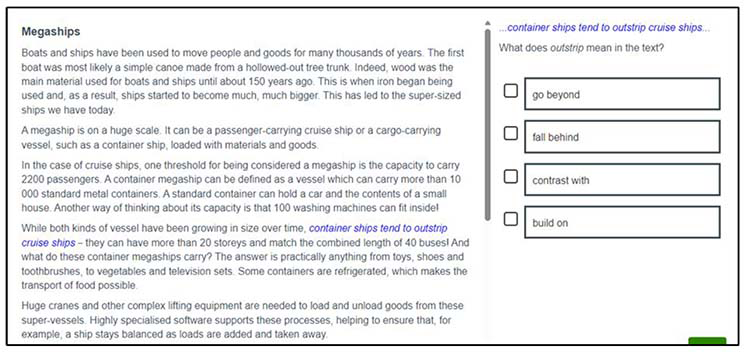
This is an information text. This item asks a learner to identify the meaning of a word in context in an information text. It required learners to identify the meaning of a word from a set of options. To help the learner locate the word in the text, the sentence where the word appears is highlighted in italic blue in both the question and the source text. This link allows the learner to understand the context of the item in order to identify the meaning of the word.
3.2.2 SNSA Finding and using information
This organiser focuses on the critical literacy skills of locating information in a text and employing the information to meet a purpose. These skills are often applied in the context of non-fiction texts but can also be applied to fiction. In the SNSA, items for P1 and P4 learners that corresponded to this organiser generally focused on finding information that was literally stated or required a low level of inference (for example, recognising synonyms linking the question with the text). More advanced items addressing similar skills – for P7 and S3 – were likely to be applied to longer and more complex texts. At P7, the organiser Finding and using information also included items requiring learners to sort information in a text into relevant categories. The S3 reading assessment presented Finding and using information items that asked learners to find key information in one or more texts, or to make connections between the information they located, sometimes across more than one source of information.
Figure 19 provides a good example of a P4 item where typically a learner is asked to find information that is literally stated in text.
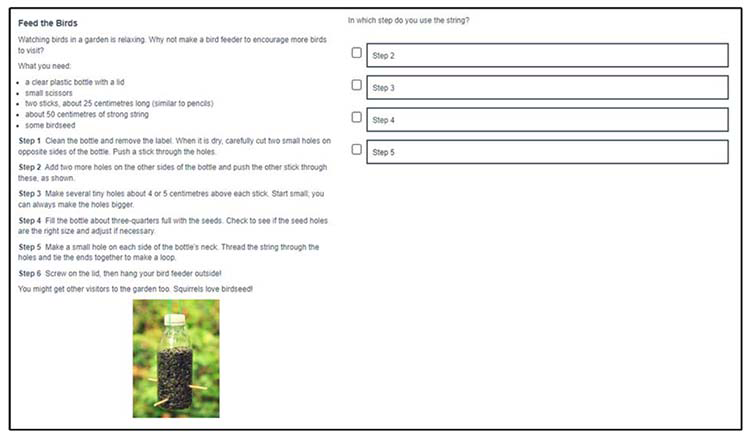
This item asks the learner to identify a step in a process in an instructional text. The learner can locate the step by linking the word string in the item to the step where the word string appears. This item is very much about the learner finding the correct bit of information.
This item was classified as being at the bottom of the P4 reading item difficulty range. It was presented to children near the beginning of the assessment, with almost all children able to answer it correctly.
Figure 20 shows a typical item from the P7 reading assessment, from the organiser Finding and using information. The stimulus for this item is a non-fiction information text of typical length within the context of the P7 reading assessment, and mainly uses relatively simple vocabulary and language structures. The item presented here required learners to find information in the non-fiction text.
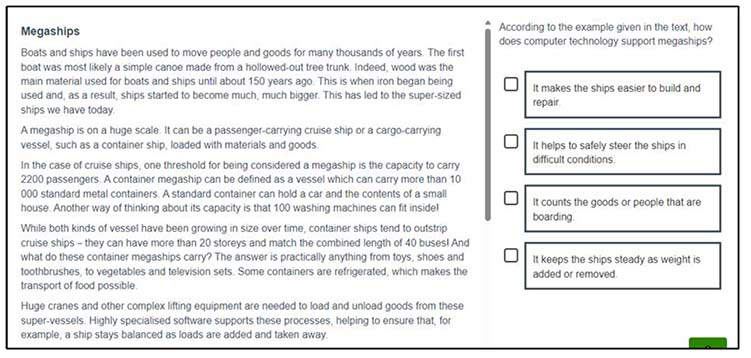
This item asks the learner to locate a paraphrased detail in the text. The information uses familiar synonymous language to help the child link the information in the text to the correct answer. The phrase “specialised software supports the processes.” in the text is the information that needs to be located by the learner.
Figure 21 shows a Finding and using information item from a S3 reading assessment. The stimulus for this item is a descriptive, non-fiction text. The text uses more complex vocabulary, including some technical terminology, and the sentences are longer and use more complex structures, providing learners in S3 with greater challenge.

The item presented here required learners to select relevant information and identify a paraphrase of a detail given in a complex information text. Learners can relate the wording in the question directly to the identical expression in the text. However, in other ways this item is considerably more difficult than the P7 example provided in Figure 14, as the text is more complex and sophisticated and the learner has to understand that a lunar crater is a part of a moon.
This unit was only seen by learners if they did relatively well in the initial items within the assessment and the item was classified as being at the high end of the S3 item difficulty range.
3.2.3 SNSA Understanding, analysing and evaluating
The essence of this organiser is comprehension, beginning with word and sentence level texts (for learners at P1) and with progressively longer and more complex passages of text providing greater challenge across all the reading assessments. While items for the P4 assessment tended to focus on main or prominent ideas, learners at P7 and S3 were asked to answer a range of literal, inferential and evaluative questions that, for example, might require learners to distinguish between fact and opinion, recognise persuasive language, use evidence from a text to support answers, or evaluate the reliability and credibility of texts.
Figure 22 is an example of a P1 item from the organiser Understanding, analysing and evaluating. It assesses reading comprehension at sentence level. In this kind of item, the child chooses an answer from a selection (multiple choice item). This skill was modelled in the practice assessment.
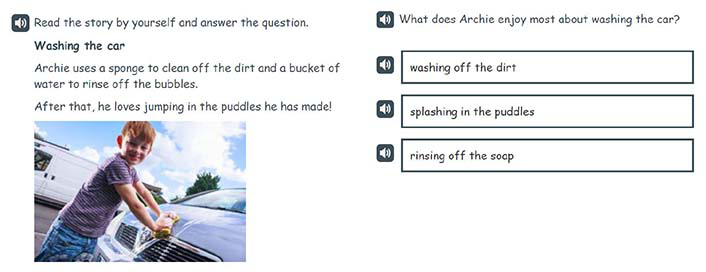
This item was rated as being at the high end of the P1 item difficulty range. The text instruction can be read to the learner using the audio button. The question and answer options also have audio support. In contrast to the Tools for reading items presented in Figures 16 and 17, the child is required to read the actual text independently. As well as being able to decode the words, the child needs to infer which part of the activity Archie enjoys the most from the sentence ‘After that, he loves jumping in the puddles he has made!’ This item therefore relies on understanding information, rather than just finding and using it. Only a minority of P1 learners presented with this item were expected to complete it successfully.
It can be seen that the example item shown in Figure 22 requires the child both to decode the words by themselves (that is, to read independently) and to understand the meaning of the sentence. Another approach to assessing the development of reading comprehension at the earliest stages is to present written texts orally. This is because young learners may have higher skills in comprehension than their decoding skills allow them to demonstrate. Accordingly, at P1, a combination of written texts with audio support and without audio support was used to assess the skills, knowledge and understanding associated with the organiser Understanding, analysing and evaluating.
Figure 23 is an example of a P4 item from the organiser Understanding, analysing and evaluating.
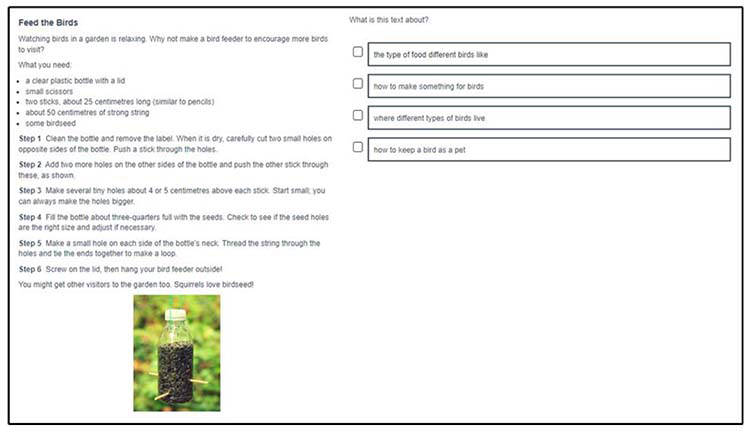
This item asks learners to identify the purpose of an instructional text. To answer this item successfully, learners must understand and synthesise information contained within the 6 steps before concluding and summarising what the text is about. This item was in the middle of the item difficulty range for P4. It was presented to learners who had done relatively well in the initial items within the assessment.
Reflecting the importance of the skills in this organiser within CfE, the larger amount of items in the S3 reading assessment for 2022 to 2023 focused on Understanding, analysing and evaluating. Like the reading assessments for P4 and P7, the texts used for the S3 assessment covered a range of text types, contexts and topics, from narrative through to information or persuasive texts, and fiction through to scientific texts or blogs. As would be expected, the texts for S3 were generally longer and more complex than for the lower stages.
The text in Figure 24 is an example of a typical text for S3.

Items in this organiser at S3 asked learners to demonstrate skills such as infer from a direct quotation a viewpoint held by a person described in a complex information text. The question requires the learner to interpret the final paragraph “Despite such accolades, Dr Rubin remained keenly aware of how much more there is to learn about the universe, saying in 2009, “I’m sorry I know so little. I’m sorry we all know so little. But that’s kind of the fun, isn’t it?” The learner is required to draw a conclusion based on the information provided in the text.
3.2.4 – MCNG Tools for Reading
In the P1 assessment, this organiser comprised items related to phonological awareness, word decoding and word recognition; in the assessments for the higher stages, assessment content mainly referred to learners' use of strategies to work out the meaning of words. The P4, P7 and S3 assessments contained relatively small numbers of items from this organiser in the academic year 2022 to 2023.
Figure 25 shows a typical item from the P4 reading assessment, which reflects the organiser Tools for reading.
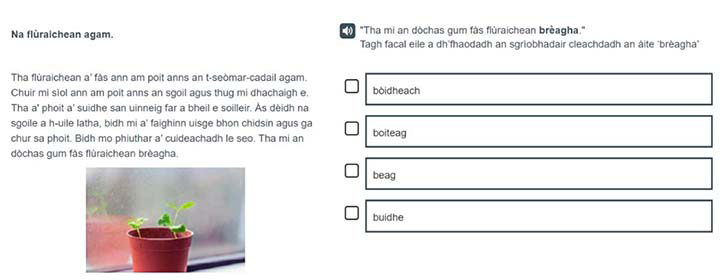
This item is designed to assess children's ability to recognise common words and suggest an appropriate synonym. Note that the 'speaker' icon indicates to the learner that there is audio support available, enabling the child to listen to the item text.
Figure 26 shows a typical P1 Tools for reading item.

This item assesses learners’ ability to identify what the sound is at the start of a word. This item had audio support for the answer options as well as the question stem, which makes this item easier for learners. Similar items without audio supported answer options would be more difficult for learners.
3.2.5 – MCNG Finding and using information
This organiser focuses on the critical literacy skills of locating information in a text and employing the information to meet a purpose. These skills are often applied in the context of non-fiction texts but can also be applied to fiction. In MCNG, items for P1 and P4 learners that correspond to this organiser generally focus on finding information that is literally stated or requires a low level of inference (for example, recognising synonyms linking the question with the text). More advanced items addressing similar skills – for P7 and S3 –are likely to be applied to longer and more complex texts. At P7, the organiser Finding and using information also includes items requiring learners to sort information in a text into relevant categories. The S3 reading assessment presents Finding and using information items that ask young people to find key information in one or more texts, or to make connections between the information they locate, sometimes across more than one text.
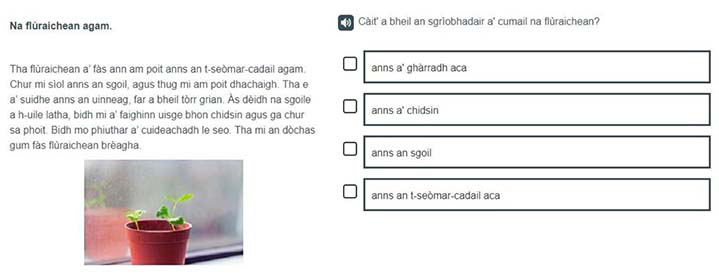
This multiple choice item assesses learners’ ability to identify information which is directly stated in the text; as such it would be an easier item for P4.
3.2.6 – MCNG Understanding, analysing and evaluating
The essence of this organiser is comprehension, beginning with word and sentence level texts (for learners at P1) and with progressively longer and more complex passages of text providing greater challenge across all the reading assessments. While items for the P4 assessment tended to focus on main or prominent ideas, learners at P7 and S3 were asked to answer a range of literal, inferential and evaluative items that, for example, might require learners to distinguish between fact and opinion, recognise persuasive language, use evidence from a text to support answers, or evaluate the reliability and credibility of texts.

This item assesses learners’ ability to understand a simple sentence in Gaelic and match it to an image. This item has audio support for the question stem, but the answer options do not. The learner must understand what they read/hear and correctly identify the image that matches the sentence. In this instance, the simple sentence states ‘Beth is walking with her dog’.
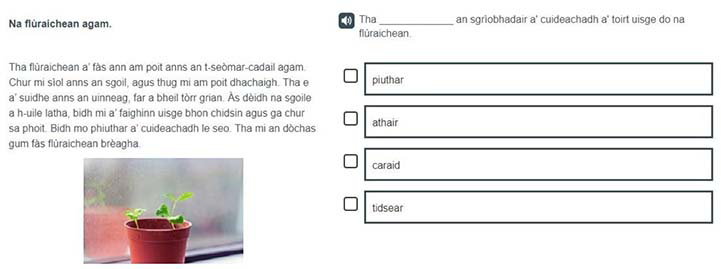
This item is an example of a sentence completion item and asks learners to identify one key word that is contained within the text. This item would be easy to mid difficulty for P4 learners as the answer is not a direct lift from the text, and it requires learners to closely read more than one sentence in order to answer it correctly.
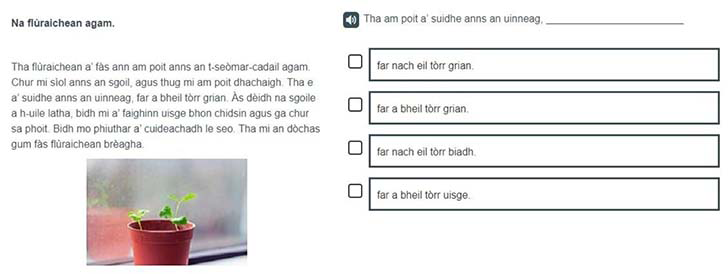
This cloze response item asks learners to identify a phrase within the text to complete the end of the given sentence. This would be an easier item for P4 as the answer is directly stated in the text. The difficulty of this item would increase should the answer not be a direct lift from the text, or if some degree of inference was required.
3.3 SNSA National outcomes for reading/literacy[8]
3.3.1 Overall outcome
Charts 14a to 14d show the overall outcomes for reading across all stages (P1, P4, P7 and S3) and outcomes in relation to the three reading/literacy organisers: Tools for reading (TFR), Understanding, analysing and evaluating (UAE) and Finding and using information (FUI). The bars indicate the proportions of learners achieving outcomes corresponding to each of the six bands reported at each stage, in line with SNSA reports for the academic year 2022 to 2023.
Please note that a ‘notable difference’ refers to a difference of 10% or more.
In line with the Office for National Statistics (ONS guidelines) data is not available for any assessments where there are fewer than 10 learners in any category or band. These cases are indicated where appropriate in this section of the report.
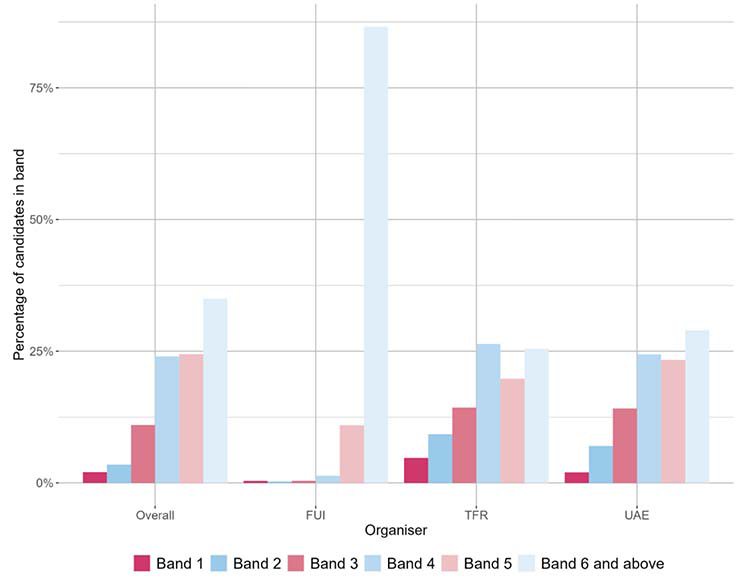
Overall, for P1, the band achieved by the largest proportion of learners was 6, and the band achieved by the second largest proportion was 5. Overall, 57% of learners achieved bands 5 or 6 and 82% of learners achieved bands 4, 5 or 6.
For the organiser ‘Finding and using information’, 87% of learners achieved bands 6.
For the organiser ‘Tools for reading’, 72% of learners achieved bands 4, 5 or 6 and 86% of learners achieved bands 3, 4, 5 or 6. This organiser did not have the largest proportion of learners achieving outcomes in band 6, instead the largest proportion of learners are in band 4.
For the organiser ‘Understanding, analysing and evaluating’, 52% of learners achieved bands 5 or 6 and 77% of learners achieved bands 4, 5 or 6.
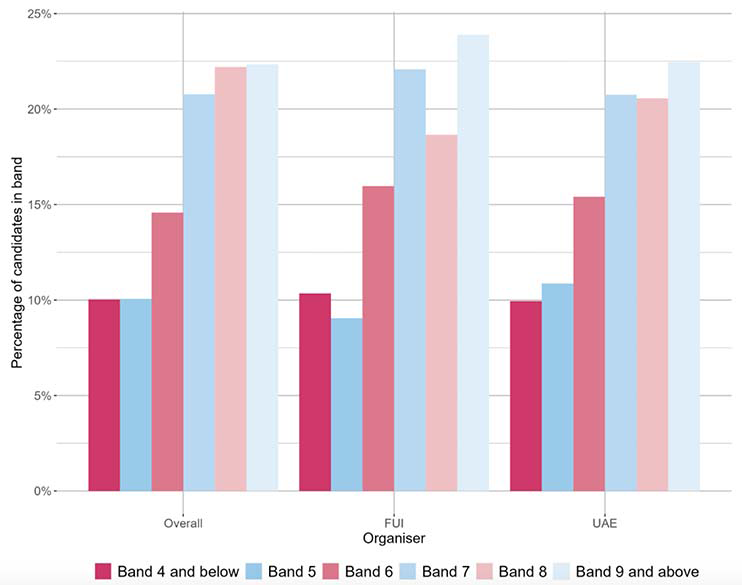
Overall, for P4, the band achieved by the largest proportion of learners was 9, and the band achieved by the second largest proportion was 8. Overall, 65% of learners achieved bands 7, 8 or 9 and 80% of learners achieved bands 6, 7, 8 or 9.
For the organiser ‘Finding and using information’, 65% of learners achieved bands 7, 8 or 9 and 81% of learners achieved bands 6, 7, 8 or 9.
For the organiser ‘Understanding, analysing and evaluating’, 64% of learners achieved bands 7, 8 or 9 and 79% of learners achieved bands 6, 7, 8 or 9.
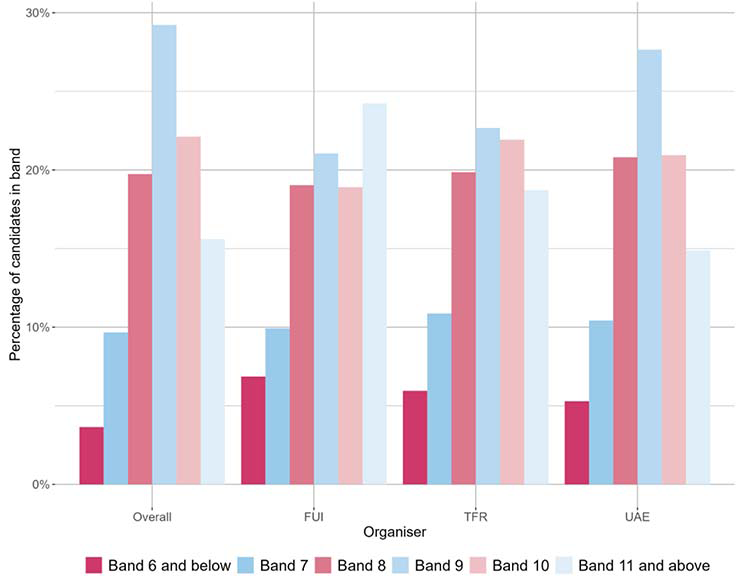
Overall, for P7, the band achieved by the largest proportion of learners was 9, and the band achieved by the second largest proportion was 10. Overall, 71% of learners achieved bands 8, 9 or 10 and 96% of learners achieved bands 7, 8, 9, 10 or 11.
For the organiser ‘Finding and using information’, 59% of learners achieved bands 8, 9 or 10 and 93% of learners achieved bands 7, 8, 9, 10 or 11. This organiser did not have the largest proportion of learners achieving outcomes in band 9, instead the largest proportion of learners are in band 11.
For the organiser ‘Tools for reading’, 64% of learners achieved bands 8, 9 or 10 and 94% of learners achieved bands 7, 8, 9, 10 or 11.
For the organiser ‘Understanding, analysing and evaluating’, 69% of learners achieved bands 8, 9 or 10 and 95% of learners achieved bands 7, 8, 9, 10 or 11.
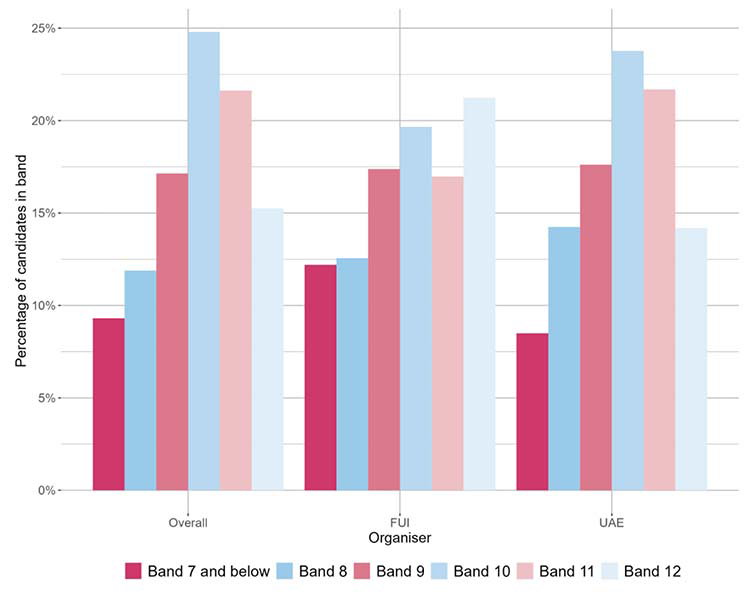
Overall, for S3, the band achieved by the largest proportion of learners was 10, and the band achieved by the second largest proportion was 11. Overall, 64% of learners achieved bands 9, 10 or 11 and 91% of learners achieved bands 8, 9, 10, 11 or 12.
For the organiser ‘Finding and using information’, 54% of learners achieved bands 9, 10 or 11 and 88% of learners achieved bands 8, 9, 10, 11 or 12. This organiser did not have the largest proportion of learners achieving outcomes in band 10, instead the largest proportion of learners are in band 12.
For the organiser ‘Understanding, analysing and evaluating’, 63% of learners achieved bands 9, 10 or 11 and 92% of learners achieved bands 8, 9, 10, 11 or 12.
3.3.2 Sex
Charts 15a to 15d show the proportions of boys and girls in each of the literacy and reading bands for all stages, both overall for reading and by organiser.
For P1 and P4, the majority of both male and female learners achieved outcomes in the upper two bands. At P1 there was a small difference between the outcomes for males and females but at P4 this was more pronounced with a greater proportion of female than male learners achieving outcomes in those bands. At P7 and S3 the largest proportions of male and female learners achieved outcomes in the middle two bands. This was the case for the overall outcomes, and generally was also the case when considering only assessment material related to each of the organisers.

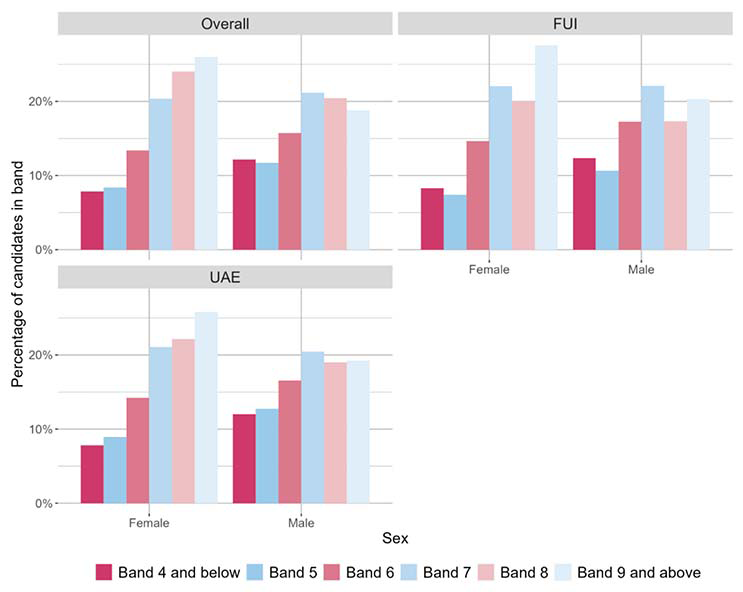
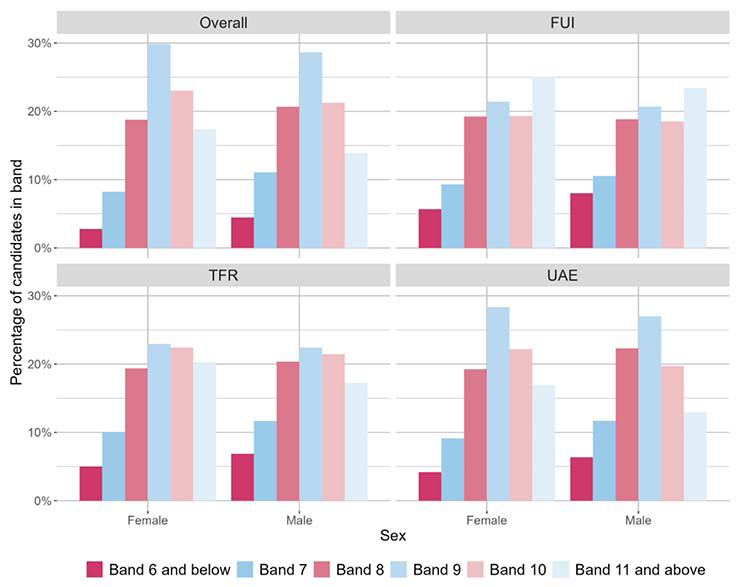

3.3.3 Scottish Index of Multiple Deprivation
This section reviews the distribution of learners for all stages across categories that reflect the Scottish Index of Multiple Deprivation (SIMD). To simplify the display of outcomes and aid their interpretation, we have divided the original 20 categories (vigintiles) into three combined categories of socio-economic background. These combined categories are: SIMD 1–4, indicating the lowest socio-economic quintile (that is, the most deprived children and young people, those in vigintiles 1 to 4); SIMD 5–16, indicating the three middle quintiles (vigintiles 5 to 16); and SIMD 17–20, indicating the highest socio-economic quintile (that is, the least deprived children and young people, those in vigintiles 17 to 20).
At each stage, the proportions of learners with outcomes corresponding to the two upper capacity bands was much larger in the least deprived group (SIMD 17–20). Likewise, there were also relatively higher proportions of learners who achieved outcomes in the two lower bands among learners classified in the most deprived group (SIMD 1–4). This pattern was present across all stages, both for reading/literacy overall and by organiser.
Charts 16a to 16d illustrate that the difference in reading/literacy outcomes between children from the most and least deprived groups (SIMD 1–4 and SIMD 17–20) was relatively small at P1, while it was more substantial at other stages. These observations apply both to overall outcome and when considering only assessment content related to each of the reading organisers.
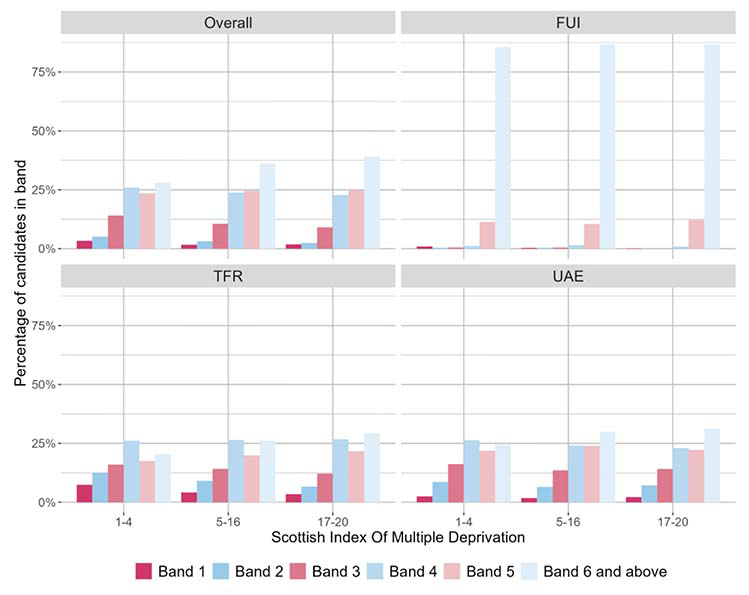
At P1, a greater proportion of children in the most deprived group (SIMD 1–4) compared to the least deprived group (SIMD 17–20) achieved outcomes in the two lower bands, while a larger proportion of children in the least deprived group (SIMD 17–20) achieved outcomes in the two upper bands. These differences were somewhat larger when considering only assessment items pertaining to the organiser ‘Tools for reading’.
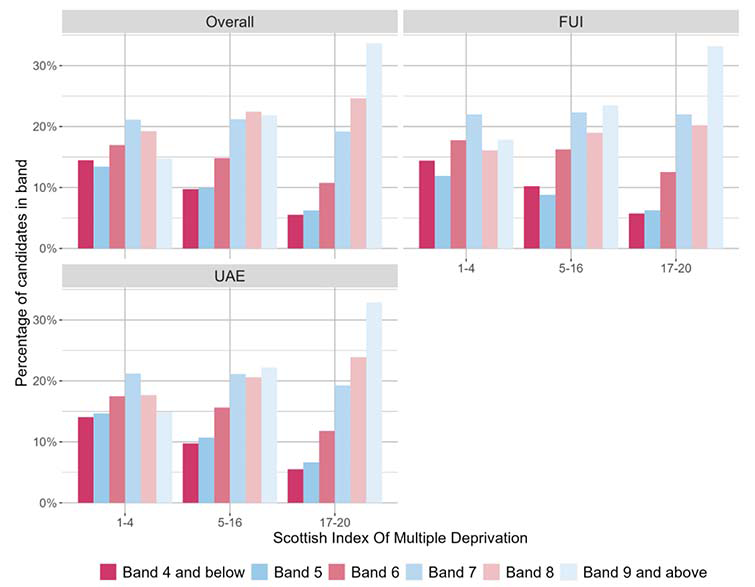
Overall, there was a notable difference between the proportions of learners in SIMD quintile 1-4 and 17-20 in band 9.
There was also a notable difference between the proportions of learners in SIMD quintile 1-4 and quintiles 5-16 in band 9 and between the proportions of learners in SIMD quintiles 5-16 and quintile 17-20 in band 9.
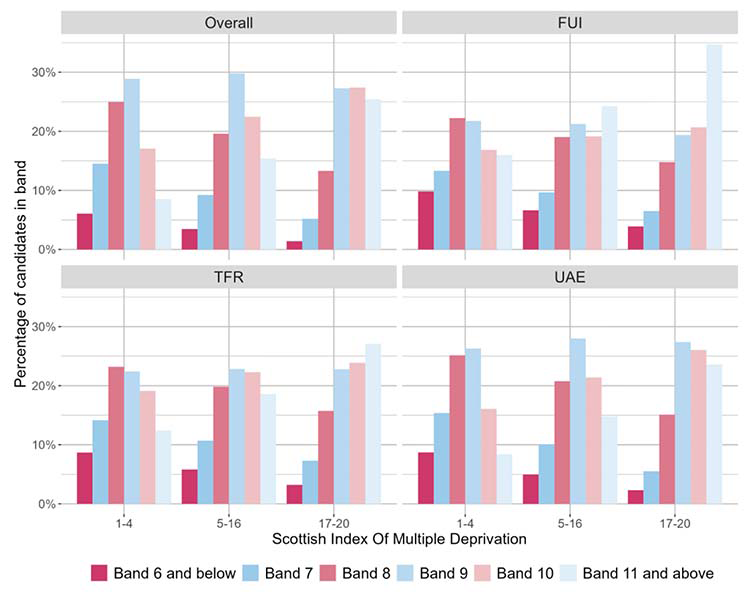
Overall, there was a notable difference between the proportions of learners in SIMD quintile 1-4 and 17-20 in bands 8, 10 and 11.
There was a difference between the proportions of learners in SIMD quintile 1-4 and quintiles 5-16 in bands 8, 10 and 11, and between the proportions of learners in SIMD quintiles 5-16 and quintile 17-20 in bands 8, 10 and 11.
Overall, there was a notable difference between the proportions of learners in SIMD quintile 1-4 and 17-20 in bands 7 and 12.
There was a difference between the proportions of learners in SIMD quintile 1-4 and quintiles 5-16 in bands 7 and 12, and between the proportions of learners in SIMD quintiles 5-16 and quintile 17-20 in bands 7 and 12.
3.3.4 Ethnic background
This section looks at differences in reading/literacy outcomes between learners classified as having 'White Scottish' and other ethnic backgrounds. Charts 17a to 17d show the proportions of learners with outcomes in each of the reading bands within each of these two groups.
The outcomes show that generally there were only minor differences in percentages for bands across the two comparison groups. This was true when reviewing the overall reading outcomes and when considering the organisers separately. At P1, the proportions of children with outcomes in the top two bands were very slightly larger for children from 'White Scottish' backgrounds. In P4, P7 and S3, there were slightly higher proportions of learners with other ethnic backgrounds in the top two bands, as compared with learners with a 'White Scottish' background.
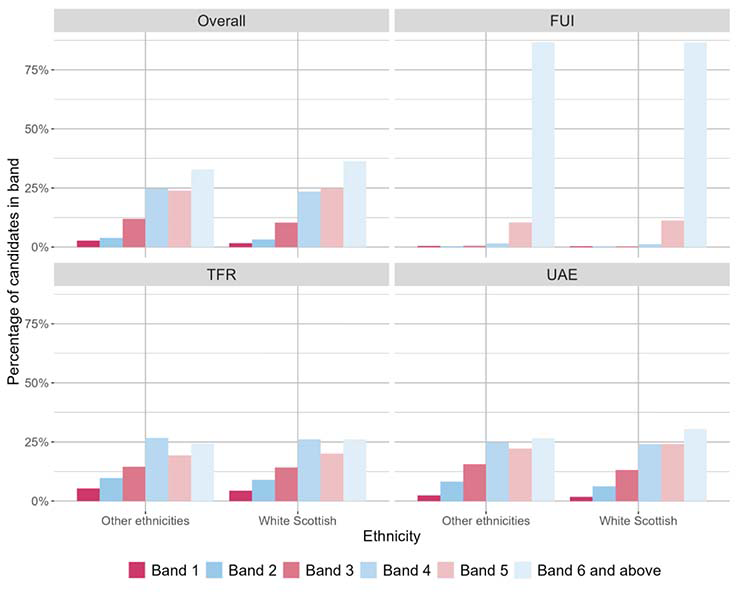

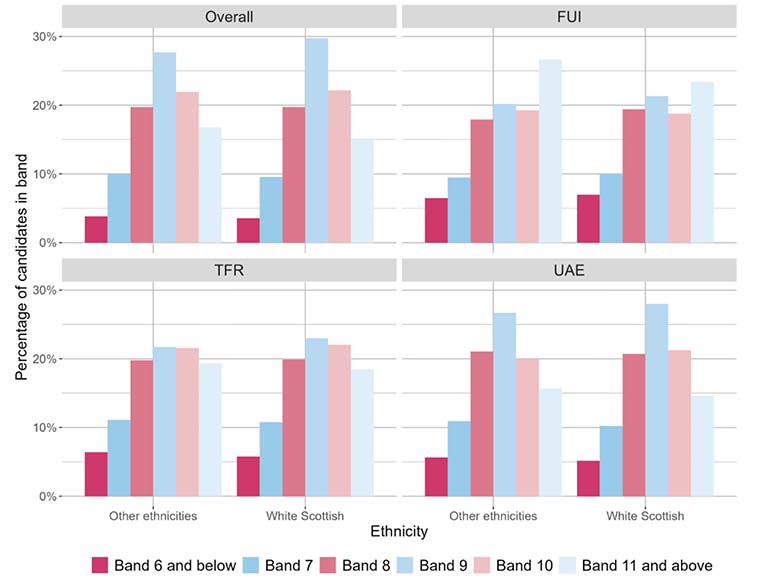
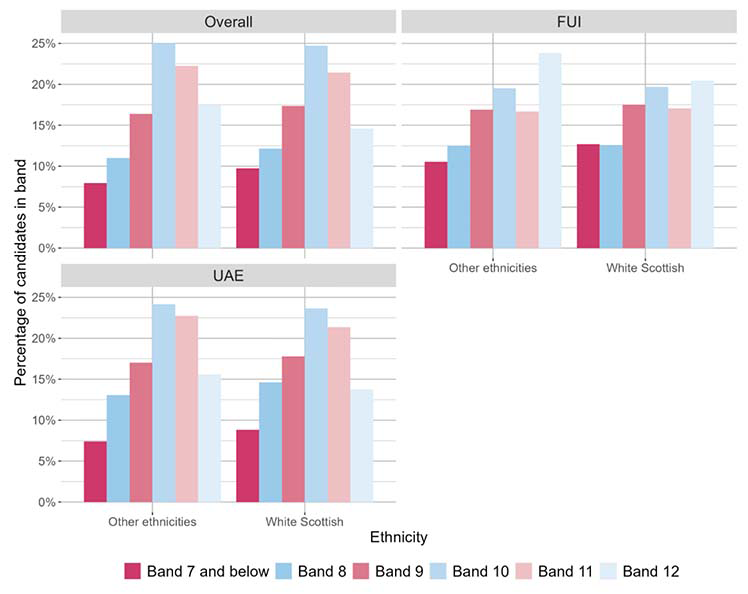
3.3.5 Free School Meal Entitlement
Charts 18a to 18d show the proportions of learners achieving outcomes across reading/literacy capacity bands, when comparing two groups defined by entitlement to free school meals. For these analyses, we distinguished those with registered entitlement from all other learners.
Across all stages, there were noticeably larger proportions reflecting outcomes in the two upper bands among learners without FME than among those with FME. There were also correspondingly higher proportions of learners with FME achieving outcomes in the two lower bands. This pattern was similar across all stages and was present for reading/literacy overall and by organiser.
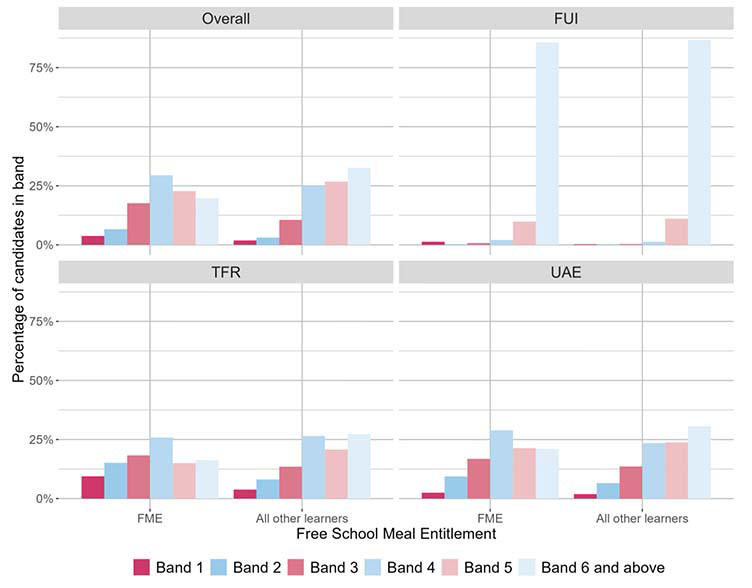

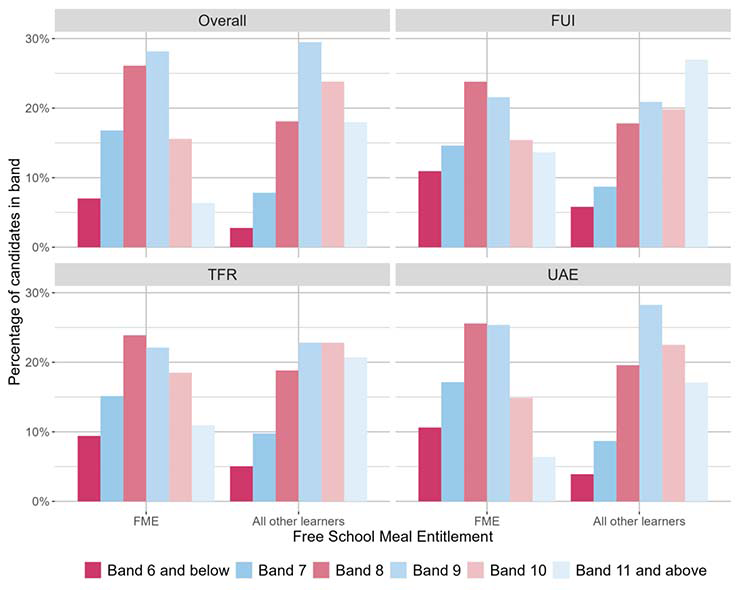

3.3.6 Additional Support Needs
Charts 19a to 19d show the proportions of learners achieving outcomes across six reading/literacy capacity bands in each of the stages, comparing the outcomes between those who were identified as having Additional Support Needs (ASN) and all others.
Across all stages, there were notably higher proportions of learners with no ASN classification who achieved outcomes in the two upper bands. There were also notably larger proportions of learners classified with ASN who obtained outcomes in the lower two bands. This pattern was seen across all stages.
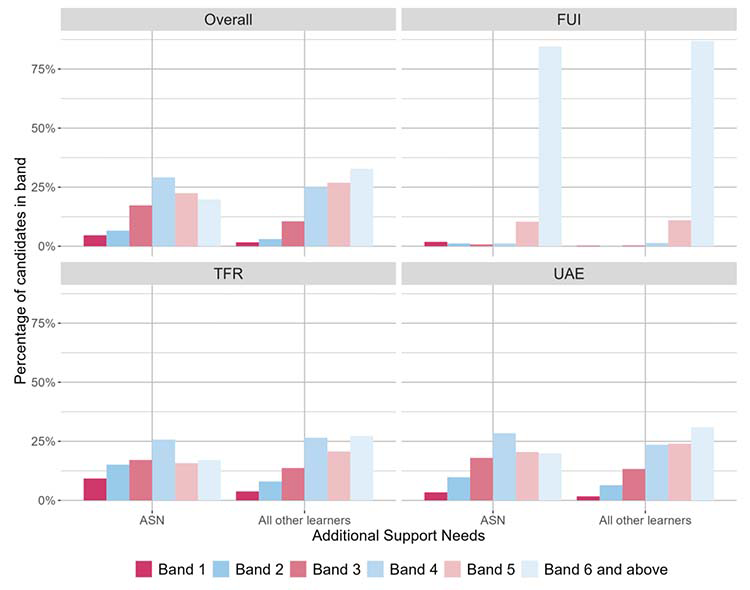
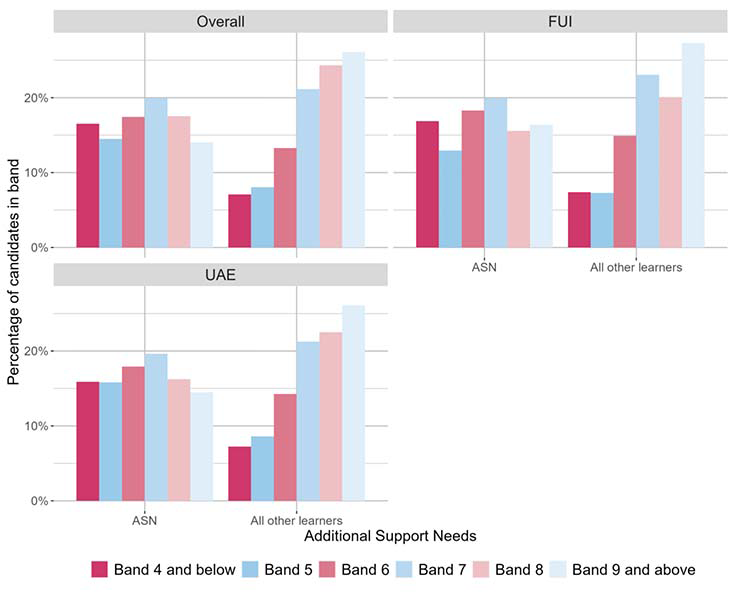
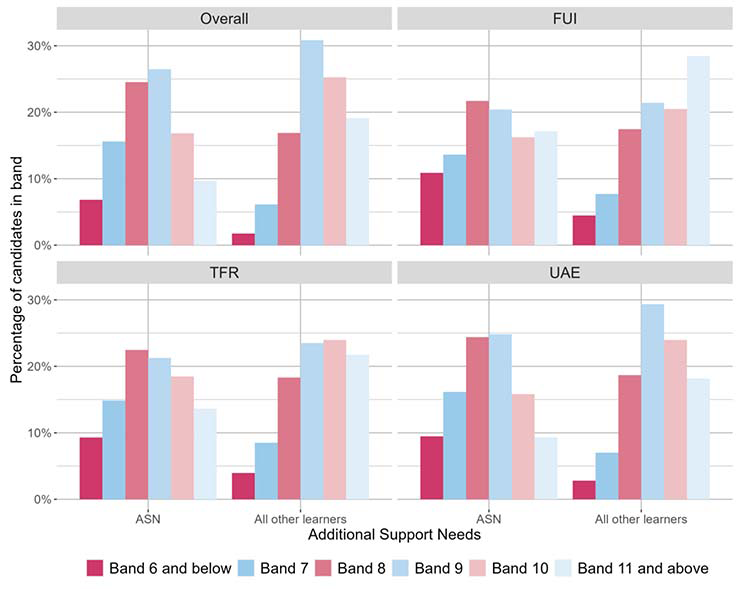
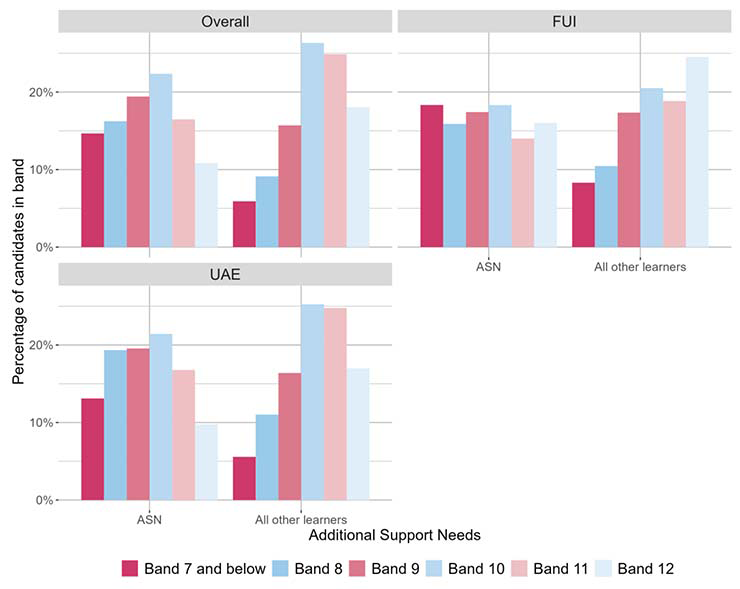
3.3.7 Looked After Children
Charts 20a to 20d show the proportions of learners achieving outcomes across the corresponding six capacity bands in reading/literacy by categories comparing learners classified as Looked After Children (LAC) with all other learners.
There were notably lower proportions achieving outcomes in the top two bands among learners who are registered as LAC than among other learners. Similarly, among LAC learners, there were also much larger proportions with outcomes in the lower two bands than among other learners. This pattern was very similar across all stages, when considering outcomes by organiser.
Though there were only minor increases in these differences between stages they did become more pronounced at each consecutive stage.
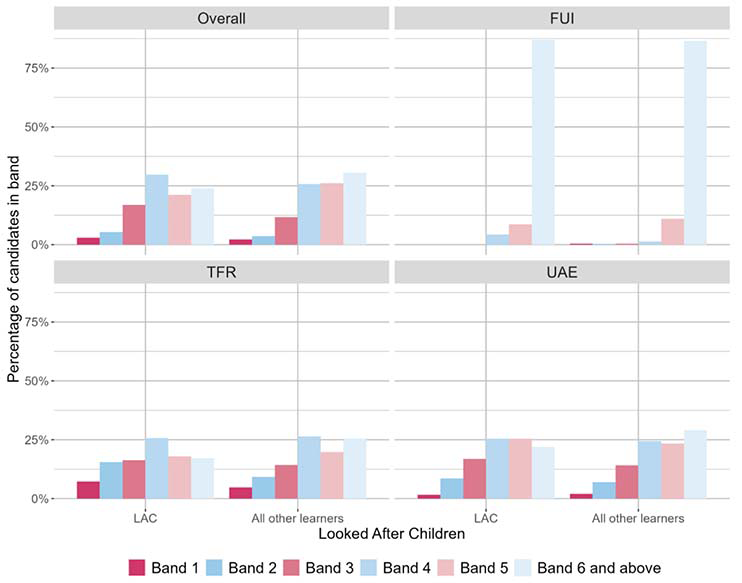
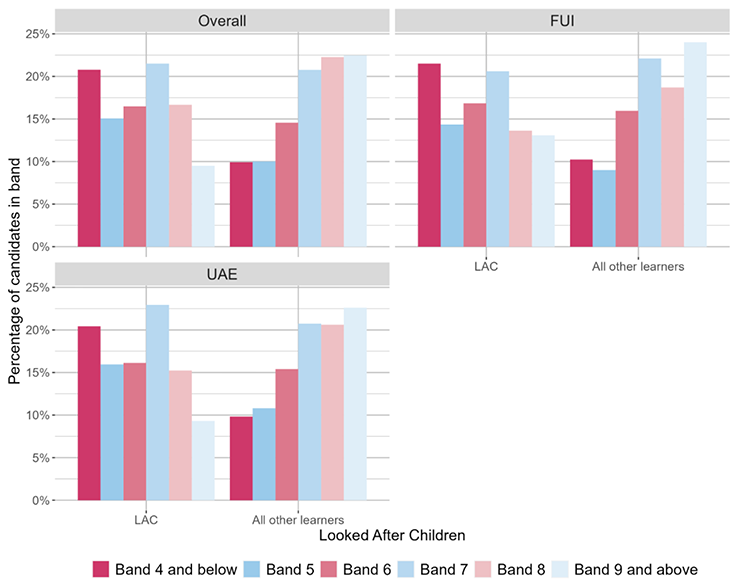

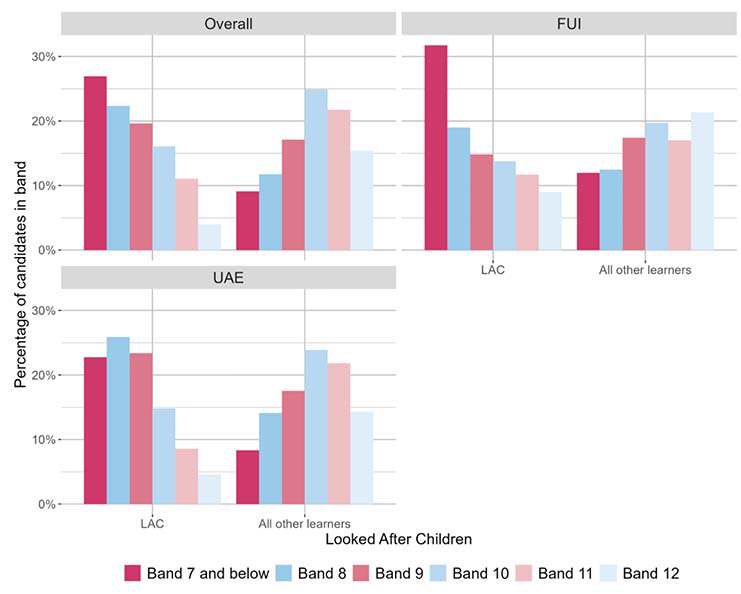
3.3.8 English as an Additional Language
Charts 21a to 21d compare learners by language background: English as an Additional Language (EAL) compared with all other learners. The category 'EAL' refers to those learners whose record in SEEMiS showed that they had English as an additional language.
The 'Not EAL' category comprises both learners who were recorded as not having EAL and those for whom there was no entry in this field.
There were notably higher proportions of learners without EAL in the top two bands at P1. At all other stages, the differences in outcomes were much smaller between learners without EAL than others both in terms of overall outcome, and when considering separately assessment content related to each individual organiser.
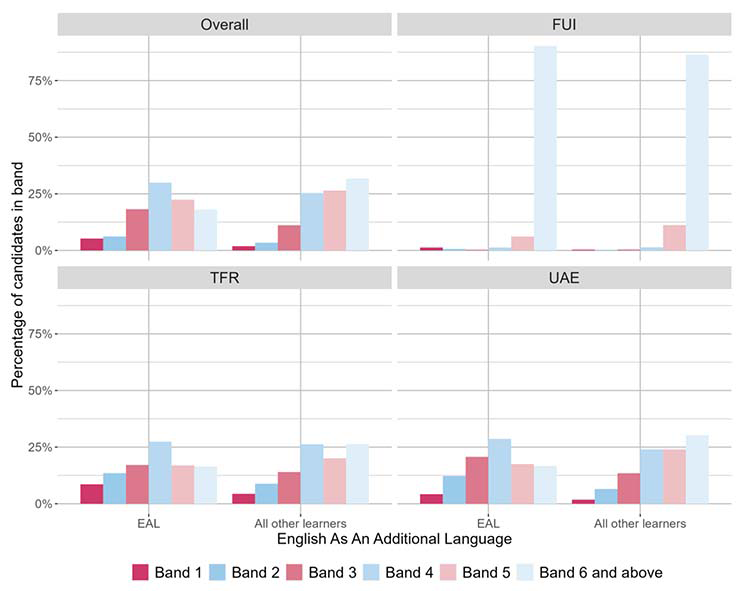


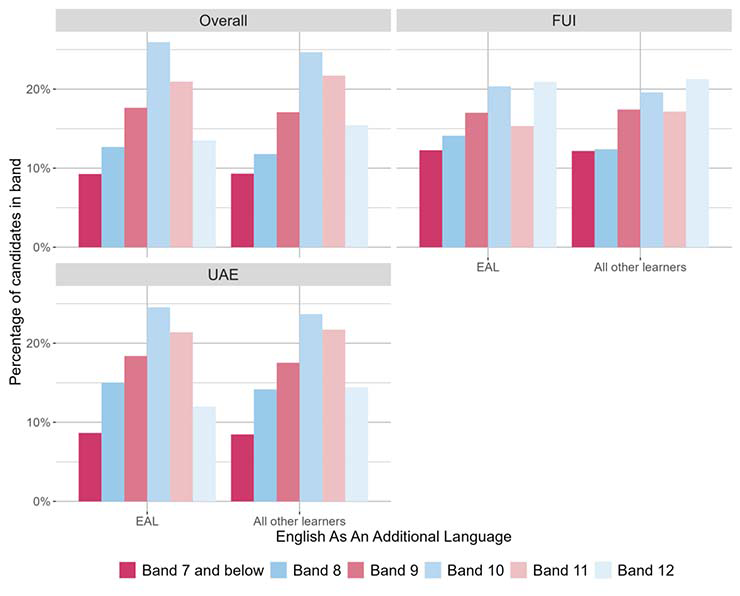
3.4 MCNG National outcomes for reading/literacy
3.4.1 Overall outcome
Charts 22a to 22c show the overall outcomes for reading and literacy across P4, P7 and S3 and outcomes in relation to the three reading/literacy organisers: Tools for reading (TFR), Understanding, analysing and evaluating (UAE) and Finding and using information (FUI). The bars indicate the proportions of learners achieving outcomes corresponding to each of the six bands reported at each stage, in line with MCNG reports for the academic year 2022 to 2023.
Please note that a ‘notable difference’ refers to a difference of 10% or more.
In line with the Office for National Statistics (ONS guidelines) data is not available for any assessments where there are fewer than 10 learners in any category or band. These cases are indicated where appropriate in this section of the report.
In line with ONS guidelines the data for P1 is not reported in order to avoid identifying individual learners.
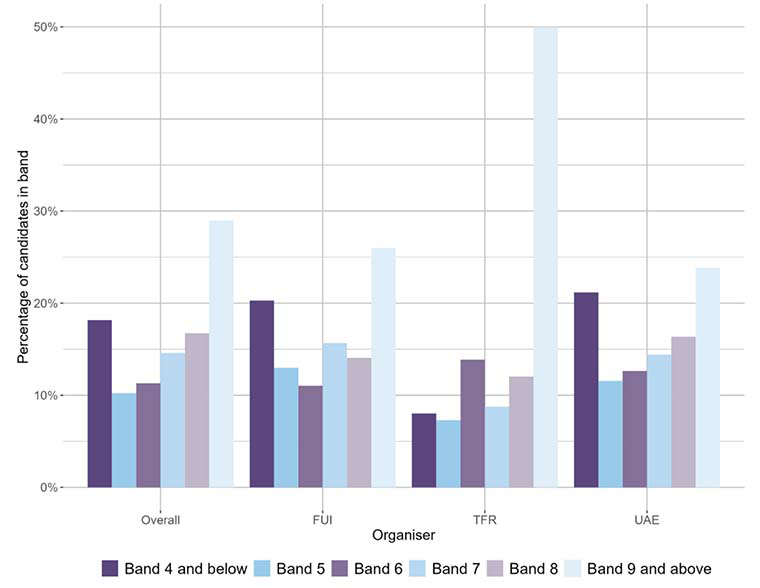
Overall, for P4, the band achieved by the largest proportion of learners was 9, and the band achieved by the second largest proportion was 4. Overall, 57% of learners achieved bands 7, 8 or 9 and 80% of learners achieved bands 5, 6, 7, 8 or 9.
For the organiser ‘Finding and using information’, 56% of learners achieved bands 7, 8 or 9 and 80% of learners achieved bands 5, 6, 7, 8 or 9.
For the organiser ‘Tools for reading’, 50% of learners achieved bands 6 and 85% of learners achieved bands 6, 7, 8 or 9.
For the organiser ‘Understanding, analysing and evaluating’, 55% of learners achieved bands 7, 8 or 9 and 79% of learners achieved bands 5, 6, 7, 8 or 9.
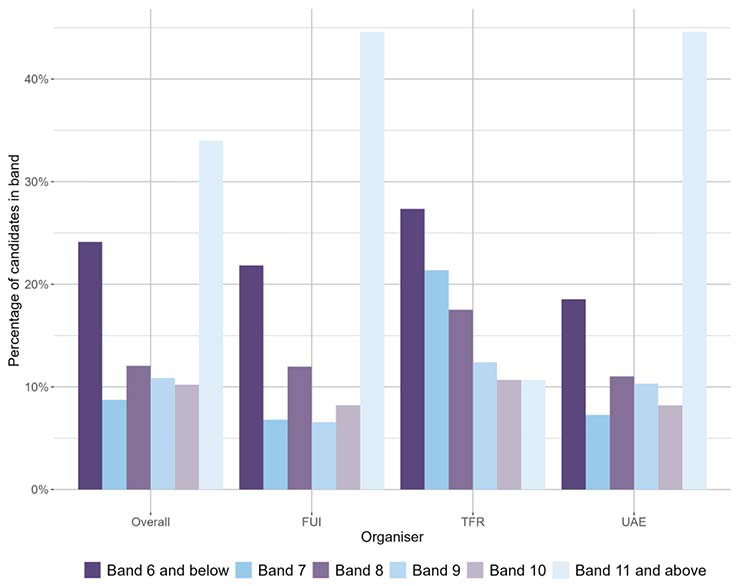
Overall, for P7, the band achieved by the largest proportion of learners was 11, and the band achieved by the second largest proportion was 6. Overall, 51% of learners achieved bands 10 or 11 and 79% of learners achieved bands 7, 8, 9, 10 or 11.
For the organiser ‘Finding and using information’, 53% of learners achieved bands 10 or 11 and 78% of learners achieved bands 7, 8, 9, 10 or 11.
For the organiser ‘Tools for reading’, 52% of learners achieved bands 8, 9, 10 or 11. This organiser did not have the largest proportion of learners achieving outcomes in band 11, instead the largest proportion of learners are in band 6.
For the organiser ‘Understanding, analysing and evaluating’, 53% of learners achieved bands 10 or 11 and 81% of learners achieved bands 7, 8, 9, 10 or 11.
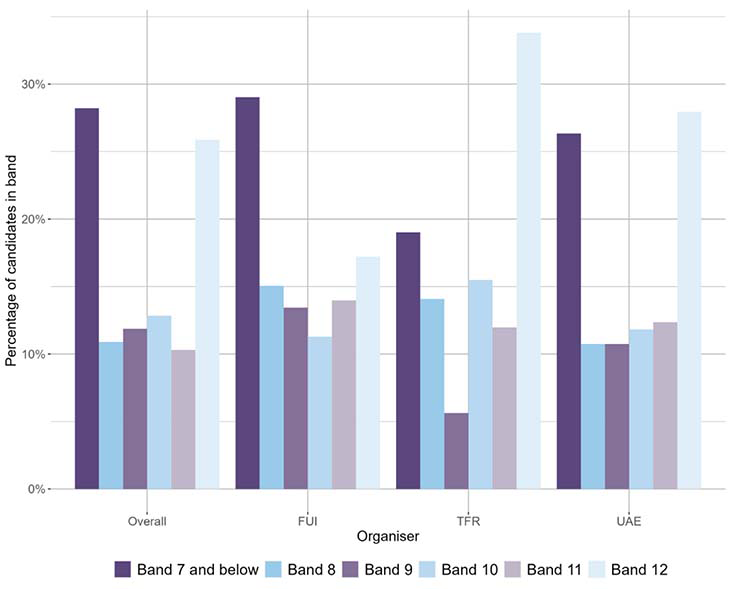
Overall, for S3, the band achieved by the largest proportion of learners was 7 (and below), and the band achieved by the second largest proportion was 12. Overall, 52% of learners achieved bands 10, 11 or 12.
For the organiser ‘Finding and using information’, 56% of learners achieved bands 9, 10, 11 or 12.
For the organiser ‘Tools for reading’, 62% of learners achieved bands 10, 11 or 12 and 82% of learners achieved bands 8, 9, 10, 11 or 12.
For the organiser ‘Understanding, analysing and evaluating’, 52% of learners achieved bands 10, 11 or 12.
3.4.2 Sex
Charts 23a and 23b show the proportions of boys and girls in each of the literacy and reading bands for all P4 and P7, both overall for reading and by organiser. In line with ONS guidelines the data for P1 and S3 is not reported in order to avoid identifying individual learners.
For P4 the majority of male and female learners achieved outcomes in the upper two capacity bands. At P7, the majority of female learners achieved outcomes in the upper two bands but the majority of male learners achieved outcomes in the lower two bands. There were similar differences between the two groups when reviewing outcomes separately by organiser content.


3.4.3 Scottish Index of Multiple Deprivation
In line with ONS guidelines the data for all stages is not reported in order to avoid identifying individual learners.
3.4.4 Ethnic background
In line with ONS guidelines the data for all stages is not reported in order to avoid identifying individual learners.
3.3.5 Free School Meal Entitlement
In line with ONS guidelines the data for all stages is not reported in order to avoid identifying individual learners.
3.4.6 Additional Support Needs
Charts 24a and 24b show the proportions of learners achieving outcomes across six reading/literacy capacity bands in P4 and P7, comparing the outcomes between those who were identified as having Additional Support Needs (ASN) and all others. In line with ONS guidelines the data for P1 and S3 is not reported in order to avoid identifying individual learners.
At P4 and P7 there were notably higher proportions of learners with no ASN classification who achieved outcomes in the two upper bands. There were also notably larger proportions of learners classified with ASN who obtained outcomes in the lower two bands.
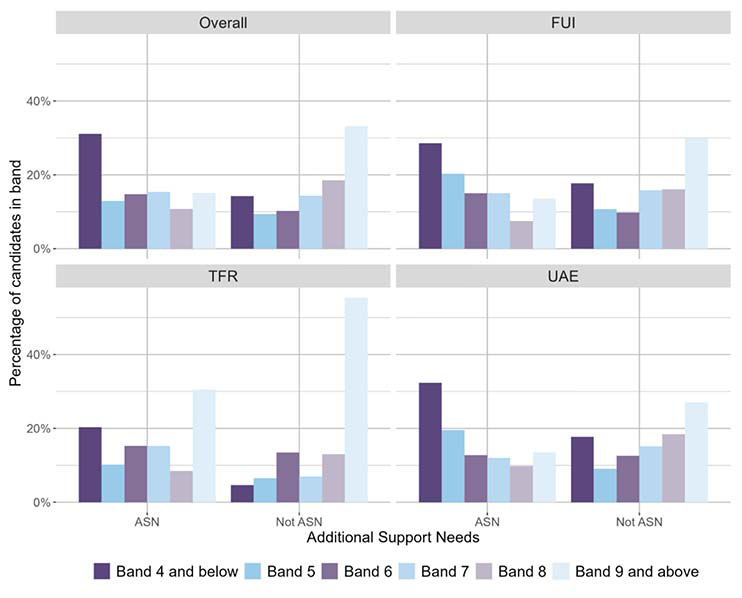
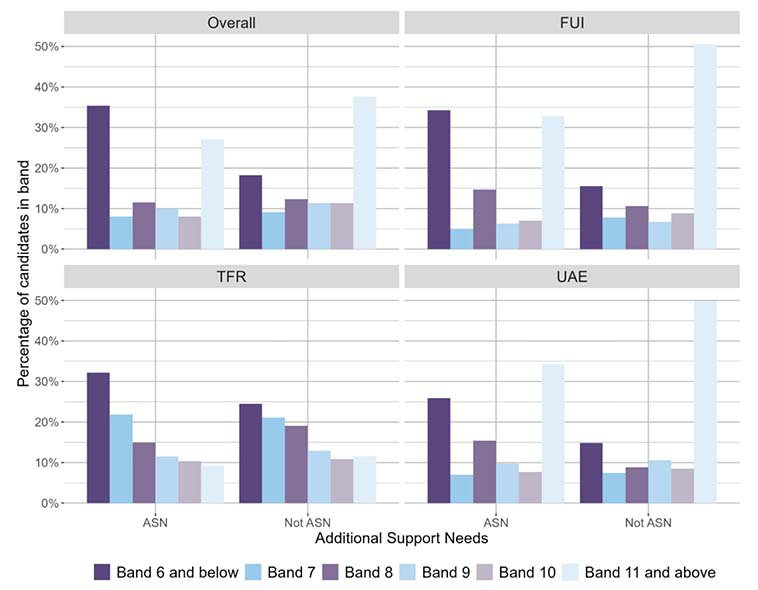
3.4.7 Looked After Children
In line with ONS guidelines the data for all stages is not reported in order to avoid identifying individual learners.
3.4.8 English as an Additional Language
In line with ONS guidelines the data for all stages is not reported in order to avoid identifying individual learners.
Contact
There is a problem
Thanks for your feedback